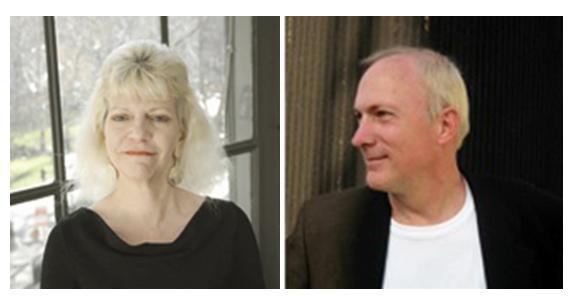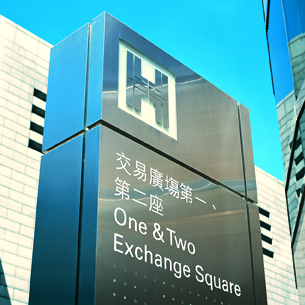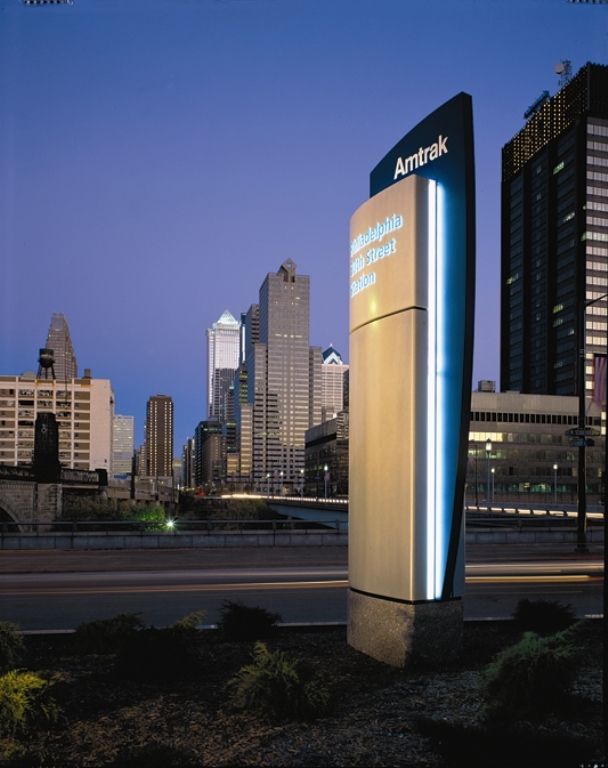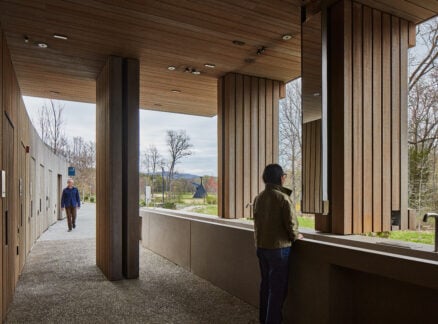
August 20, 2013
Q&A: Chris Calori on Merging Graphic, Product, and Architectural Design
On achieving success in a profession that melds graphic, product, and architectural design
To extend the conversation that Alexandra Lange kicked off in Architecture’s Lean In Moment , I set out ask five prominent women in architecture, landscape architecture, and now in graphic and communication design. This interview with Chris Calori, AIGA, SEGD, and principal of Calori & Vanden-Eynden Design Consultants (C&VE) touches on a little-understood design specialty, environmental graphic design. A relatively new profession, EGD has evolved through the efforts of design thinkers like Chris, who studied to be an industrial designer and a visual communicator. She is proud to call her profession “pretty egalitarian, with many females in leadership roles, typically as principals of their own design firms or as leaders of in-house studios. I checked with the Society for Environmental Graphic Design and 45% of our membership is female!”
With partner David Vanden-Eynden, who is also a fellow of the SEGD, C&VE’s collective experience adds up to 50 years of solving clients’ large-scale signage problems, phased-in implementations of designs, and making sure that their installations perform over time. Here Chris talks about her experiences in a changing culture as well as her firm’s work in far-flung corners of the earth and what she’s learning form her contacts there. She also gives some advice to the new grads, especially those who might be a bit frustrated with their first jobs.

Chris Calori and David Vanden-Eynden
Chris Calori headshot Courtesy David Beyda & David Vanden-Eynden headshot Courtesy C&VE
Susan S. Szenasy: As a design professional who, by the very nature of your activities, needs to have solid working relationships with other design specialists and client groups of many different types, can you talk about how you navigate these relationships today as opposed to when you started out in the field? In this moment of “lean forward” for women in design, what is your evolving experience as an expert in a group of other experts?
Chris Calori: Signage and wayfinding design is still a young field—our professional organization, the SEGD, is just celebrating its 40th anniversary this year—and convincing people of the value of signage design can still be a difficult sell. Once you have convinced a client—be it an architect, developer, institution, or corporation—that they need your services, then you as a female designer need to be completely credible, completely knowledgeable, and completely professional in all of your work and relationships with the project team. I don’t think that has changed at all.
Several things have changed, though. One is that I know more now than I did when I started out, and I can see acknowledgement of that in myself—I feel more confident–and in the eyes of teammates, who see me as more of an expert. The other thing that has changed is that as teams get more diverse in gender, race, age, and so on, there’s more acceptance and respect for those who bring this diversity to the table. In addition, clients and other design professionals have incrementally gained awareness of and respect for the EGD field and the value it adds to a project.

Connect 12 Signage, Wayfinding, and Branding Program.
The “Connect 12” program forms a thread of brand continuity by connecting the client’s twelve properties with multiple street and pedestrian bridge destinations covering over 20 blocks of bustling Central Hong Kong.
Courtesy Graham Uden
SSS: C&VE is involved in large-scale, phased-implementation work on many sites worldwide. This, of course, requires solid, long-term relationships with clients as well as collaborators. What’s your advice to those who are hoping to learn from your experience of collaborative work? What’s your secret for fruitful, positive collaborations?
CC: Design is an inherently collaborative process, so you should come to the relationship with a cooperative rather than an adversarial spirit. Of course, you must bring your knowledge, expertise, and conviction to the relationship, but you also must be able to give and take, to learn when to spend your political capital and when to compromise. I think professional women are often either too quick to fold or too unyielding on everything. The key is to find a balance between the two.
It’s my experience that the majority of project teams are primarily comprised of men. This can be intimidating in and of itself, and then some of those men can bring an adversarial attitude to the project. It’s really hard to collaborate freely in an adversarial situation without being mowed down or constantly having to prove yourself. Again, you need to be completely knowledgeable, credible, and cool-headed to prevail in such circumstances—basically you need to best your own adversary; this is unfair, but it is reality. Justifying and selling your work is a normal part of any collaborative venture, particularly in a subjective field like design; because the playing field is defined by men, I think women can be at a disadvantage if they can’t substantiate their work in a rational, unemotional manner.
We had one project—a very cool, high profile one—on which the project architect was extremely adversarial. His attitude made our meetings unbearably confrontational, to the point that I resigned the project, and my partner took it over. I thought that perhaps I was being overly sensitive, but my (male) partner soon found that he also became an object of this person’s confrontational attitude. Nevertheless, we gritted our teeth and rode out the project. Some years later we ran into the architect at a party. He apologized for his behavior towards us on the project, saying that he was undergoing anger management therapy at the time. So, in this case, the hostility wasn’t completely rooted in sexism, as I had thought, but also in an underlying personality issue.

Acela High Speed Rail Station Signage.
Sleek airfoil shapes reflect the streamlined, high-speed Acela trains, linking important passenger information directly to the Acela brand at sixteen architecturally diverse Northeast Corridor stations from Boston to Washington, DC.
Courtesy Elliott Kaufman
SSS: Have you, in your years of practice or even now, found some of your collaborators to be more progressive than others? Which ones are the best to work with, which could use some remedial lessons, and why? I’m interested in types of collaborators such as planners, architects, developers, owners, etc.
CC: Yes, even in today’s world, some of my collaborators are more progressive than others. I’m not sure that it’s completely field-related or individual-related—it’s probably a combination of both. Of the fields you’ve mentioned, I would have to say that how good their practitioners are to work with depends on how much they’ve interacted with professional women in college or on the job and/or whether women are on the project team. The more women they’ve interacted with and the more women on the project, the better.
Key collaborators in our field are the producers of our work, be it sign fabricators or print vendors, and they can present challenges at times. I once had a banner maker tell me he couldn’t match his silkscreen inks to my industry standard Pantone colors because they were “feminine”—you could see the smoke coming out of my ears!
Another time, our junior designer and I had a conference call to discuss technical items with a print vendor in Chicago. The guys on that end started out solicitously, politely brushing off our questions and calling us “gals.” As the call progressed, they probably realized that we knew more about technical matters than they ever thought possible about “gals.” They switched to calling us “girls,” then “ladies,” and then “women” by the end of the call. It was funny/sad—you could almost see the men backpedaling—but our junior designer was shocked because she had never before encountered such a patronizing attitude. Yes, it’s gotten better, but these attitudes still persist in the work world, and it jolts our female designers the first time they run up against it. Our office provides a supportive environment for female designers, including helping them deal with people who may not view them as equals.
SSS: How do you go from a degree in industrial design and visual communications to being a master at environmental graphic design? I ask this because so many young people coming out of school may be interested in hearing how life and work and specialized knowledge can evolve over time and create a whole new set of opportunities.
CC: Well, my brother got an economics degree, and now he’s an airline captain, without ever serving in the military. My point is that few people have their lives or careers charted out when they think about college or decide on a major, even though there’s great pressure to do so in our current economy. Many graduate and become huge successes in something they never studied in school, by creating synergies based on their college and life experiences combined with openness to new opportunities.
In my case, the industrial design department [at Ohio State University] offered three majors: product design, graphic design (visual communication), and interior design. In our sophomore year, all majors shared foundation classes in 2D and 3D design, as well as design theory. In our junior year, our classes focused on our major disciplines, with some collaborative projects between the majors. For me, this interdisciplinary design education was fertile ground for the hybrid field of EGD, which melds various aspects of graphic, product, and architectural design. The focus on design theory and on a systematic, problem-solving approach to design provided a strong foundation for the rigors of EGD work, and for substantiating design solutions in a rational manner.
I love design because it always presents new opportunities and new challenges, even as you acquire knowledge based on your past experience. No two design problems are the same, and neither are the solutions. And this constantly increasing knowledge affects your approach to solving each new design problem. You change, the world changes, and all that you experience is synthesized in each and every design solution. Design is a very dynamic activity that builds bridges and expands horizons, and if that ever stops, it’s time to quit the field.

Virginia Beach Convention Center Signage.
Reflecting the spirit of this seaside resort city, the sculptural white sign forms embody the profile of a sail, complementing the nautically-referenced architecture of this award-winning civic landmark.
Courtesy Chris Crumley
SSS: Your work on mixed-use developments in the Middle East and the Far East is especially interesting to me. Who do you work with in those regions; does it start with American planners/architects or does the work come from developers there? Are you working mostly electronically or do you make regular visits? What are you learning about yourself and your work as you immerse yourself in local cultures
CC: My first signage design experience was as a member of an in-house team at a major engineering firm that was designing and building a huge transportation project in Saudi Arabia. It was okay for me to work on the team here in the states; at the time, women could not work there. We have since worked on some projects in the Middle East, mainly the Emirates, which are more progressive about women working and presenting there. Most of our projects in the Emirates have been through architectural firms that do all the presenting and field representation.
Our work in the Far East, including Hong Kong, China, and Singapore, has been fascinating. The work in Asia has stemmed from our relationships with architectural firms, primarily US firms, but also some there. The licensed Chinese translation of my book, Signage and Wayfinding Design: A Complete Guide to Creating Environmental Graphic Design System, has just been released, which is very exciting, and we hope it leads to more opportunities in Asia.
It’s difficult to see through the cultural filters, but at least in China, there seems to be more equality between women and men based on my experience on design teams. Singapore and Hong Kong have the British legacy, which perhaps clouds gender relationships a bit, but I’ve never really experienced it. I think this partially stems from the fact that the entire western project design team is regarded as an expert in Asia therefore all members are highly esteemed, regardless of gender. In overseas work, we all become cultural ambassadors and design is the currency, which is humbling and exhilarating at the same time.
China is a very homogeneous society, united by language, culture, and ethnicity. Singapore and Malaysia, on the other hand, are very diverse. I’ll never forget a visit with a sign fabricator in Kuala Lumpur, Malaysia who was building the sign program for one of our Singapore projects. The shop owner was a Chinese Taoist with a project management team comprised of a Chinese Christian female, an American expat from South Carolina, and various Malays. The shop ran the gamut from meat locker-cooled clean rooms for the art and imaging departments to canvas-shaded outdoor patios where Malay Muslim workers in loincloths welded together fabricated metal letters in the tropical heat and humidity, their work interspersed with their daily ritual prayers. They all spoke a primarily English patois that I couldn’t quite understand, and they all worked together smoothly and did a great job on our project. It was one of many eye-opening experiences that I’ve been fortunate to have in our work in Asia.





